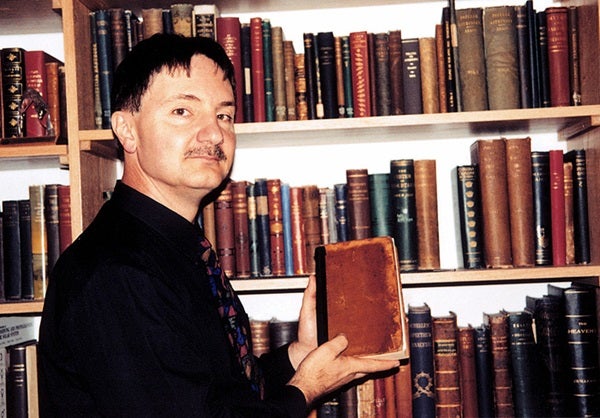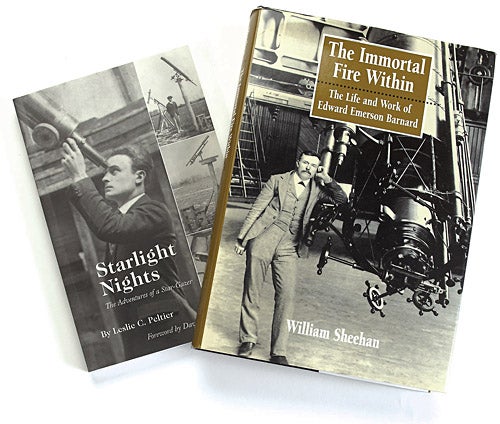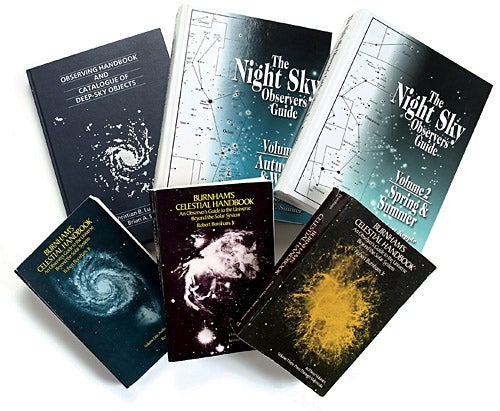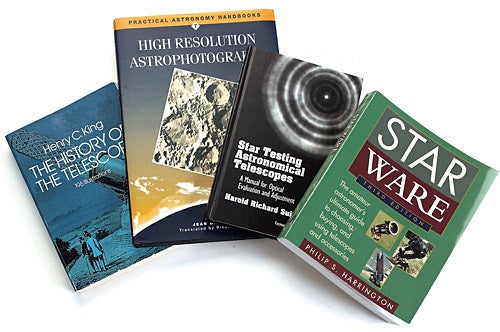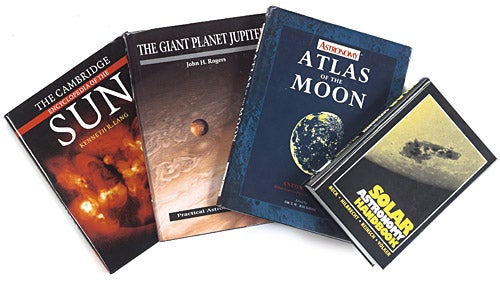For a hobby populated largely by gear-heads, it might be surprising that one of the most popular accessories in amateur astronomy is low-tech: books. In every recent survey, Astronomy subscribers listed reading second only to observing as their leisure activity of choice. Sky-gazers purchase lots of books.
Survey yourself
Start with what interests you. This may sound simplistic, but unless your shelf space and bank account are limitless, you’ll probably have to build your library slowly. So begin with titles that match your interests. For example, if your first love is astrophotography, look for a copy of Jean Dragesco’s classic: High Resolution Astrophotography (Cambridge University Press, New York, 1995).
| The find of a lifetime | |
| When I’m contemplating whether to venture into a used bookstore, I think of three little words that have long served me well: You never know.
On a visit to Chicago in the late 1970s, I saw the word “bookstore” out of the corner of my eye. Finding a parking spot blocks away, I excitedly walked back only to discover the shop’s full name: The Occult Bookstore. My excitement quickly evaporated. But I was there, so in I went. I meekly asked the clerk if they had any astronomy books, and she pointed upward without taking her eyes off the chart she was studying. I rolled the ladder over, climbed to the top shelf, and almost fell off when I saw a first edition of Mary Somerville’s Mechanism of the Heavens, written in 1831. This book catapulted Somerville — a Scottish housewife — to superstar status in the early 19th century. Only 750 copies of the first edition were printed, and few of those made it across the ocean to America. I believe it is the most important astronomy book ever written by a woman. With trembling hand, I looked for the price: $13.98 had been crossed out and $9.98 written beside it! Today, the book goes for more than a hundred times that, if you’re lucky enough to find it at all. You never know. |
|
Buy the best books you can afford, but don’t get hung up on first editions unless you’re building a collector’s library. Later editions generally will contain more material and will be more factually accurate. For used titles, consider the book’s overall condition. Are all the pages intact? Is the binding secure? How does the cover look? Obviously, if you decide to sell the book someday, you’ll get a higher price for it if it’s in good condition.
How many books should you aim to collect? That depends on your desires and resources, but an acquisition schedule is probably a good idea. When I first started collecting, I resolved to purchase one new title a month. After collecting for several years, I noticed I was buying more than my stated goal, probably a book every two weeks. Today, I average a new astronomy book each week. If you do this for several years, you’ll be amazed at the number of books you’ll amass.
Start and stay organized
About 15 years ago, I called my friend Ray who lived a couple of states away to ask if he had a certain book. Ray instructed me to go into my living room and look in the middle of the third shelf of the bookcase closest to the front door. I was incredulous when I discovered the very book I’d called about. The fact that someone knew my books better than I did so shocked me that I resolved to organize my collection.
I now have a detailed inventory, sortable by each book’s author, title, date of publication, or subject. In the spirit of redundancy, I keep the database saved on my computer, printed in hardcopy form, and stored in my PalmPilot (the latter is especially handy in bookstores). Last but not least, I keep a hardcopy off-site — at Ray’s, of course.
Shop till you drop
Support your local bookstores. It won’t take long to memorize their layouts: The important areas are the science section, order desk, and — for caffeine junkies — the coffee bar. Used bookstores are great for locating out-of-print, classic titles. Once the owner recognizes you as a returning customer, he or she is more likely to purchase astronomy books and to let you know when they arrive.
Recommendations
If you’re like me, you (quite unrealistically) desire all astronomy books, but certain books stand out as “must haves.” In this article, I include a few titles that fall within some of the more popular astronomy categories: star atlases, observing guides, and books about cosmology.
Starting on the non-technical side, I strongly recommend two biographies. Actually, the first is an autobiography and necessary reading for amateurs. Starlight Nights: The Adventures of a Star-Gazer by Leslie C. Peltier (Sky Publishing, Cambridge, Massachusetts, 1999) is an inspirational account of the lifelong journey of an amateur astronomer. The other is The Immortal Fire Within: The Life and Work of Edward Emerson Barnard by William Sheehan (Cambridge University Press, New York, 1995). Immortal Fire highlights one of the most famous professional astronomers — and one of the greatest visual observers — who ever lived.
Although there is no shortage of good sky guides, only one is indispensable, and it has been around for a quarter-century: Burnham’s Celestial Handbook: An Observer’s Guide to the Universe Beyond the Solar System by Robert Burnham, Jr.
(3 volumes, Dover Publications, New York, 1978). Burnham’s truly is the bible of observing, and I say that with full knowledge of the great number of mistakes and old data found within its more than two thousand pages. This set of books simply must be on your shelves.
If you have a 10-inch or larger telescope, I highly recommend The Night Sky Observer’s Guide by George R. Kepple and Glen W. Sanner (2 volumes, Willmann-Bell, Richmond, Virginia, 1998). It is a superb collection of celestial details seen by the authors, both of whom are top-notch observers.
The best sky guides are written by observers who live for the next clear night. Two such individuals are Christian B. Luginbuhl and Brian A. Skiff. More than a decade ago, they produced a work entitled Observing Handbook and Catalogue of Deep-Sky Objects (Cambridge University Press, New York, 1989). This book provides accurate data for 2,050 objects, all of which the authors observed through 6-inch and 10-inch telescopes.
Tools of the trade
Books about telescopes are not as common as one might think, probably because each scope comes with an operator’s manual. An excellent book that covers many of the technical aspects associated with telescopes is Harold Richard Suiter’s Star Testing Astronomical Telescopes (Willmann-Bell, Richmond, Virginia, 1994). Please note: This is not a book for beginners — it is for serious amateurs who want to evaluate their optical systems.
For an historical look at telescopes and a great reference detailing how modern telescopes came to be, read The History of the Telescope by Henry C. King (Dover Publications, New York, 1979). This book will give you plenty of background information and makes for great reading on cloudy nights.
The solar system
So many books about the Sun, Moon, planets, comets, asteroids, and the other denizens of the solar system have been written that choosing only a few to highlight seems impossible. Certain titles do stand out, however.
Two excellent books on our daytime star are The Cambridge Encyclopedia of the Sun by Kenneth R. Lang (Cambridge University Press, New York, 2001) and Solar Astronomy Handbook by Rainer Beck, Heinz Hilbrecht, Klaus Reinsch, and Peter Völker (Willmann-Bell, Richmond, Virginia, 1995).
The Giant Planet Jupiter by John H. Rogers (Cambridge University Press, New York, 1995) is a profusely illustrated guide to Jupiter. My choice for Saturn is a bit more dated but contains an incredible amount of historical information: Arthur Francis O’Donel Alexander’s The Planet Saturn: A History of Observation, Theory and Discovery (Dover Publications, New York, 1980).
Books with a (BIG) bang
Amateur astronomers love learning about the Big Bang, the inflationary universe, dark matter, and black holes. One classic work in this genre is Stephen Hawking’s A Brief History of Time: From the Big Bang to Black Holes (Bantam Books, New York, 1988). Published more recently, The Whole Shebang: A State-of-the-Universe(s) Report by Timothy Ferris (Simon & Schuster, New York, 1997) provides a good overview of the state of cosmology. Both are clearly written and relatively non-technical.
Miscellaneous
Rather than listing more categories, I have placed a few of my favorite books into one last catchall subdivision. No better reference exists for the dates and times of astronomical phenomena than Jean Meeus’s superb Astronomical Tables of the Sun, Moon and Planets (Willmann-Bell, Richmond, Virginia, 1995). Here you will find dates, times, distances, and angular sizes for martian oppositions through the year 3000, phases of the Moon and solar and lunar eclipse data through 2050, all planetary occultations through 2020, and much more.
Most observers appreciate a rich meteor shower. A highly illustrated book that describes the parent bodies of these events is The Cambridge Encyclopedia of Meteorites by O. Richard Norton (Cambridge University Press, New York, 2002).
For observers of relatively bright deep-sky objects, Messier’s Nebulae & Star Clusters by Kenneth Glyn Jones (Cambridge University Press, New York, 1991) is a detailed reference. In addition to locator maps and information about the objects, this book contains many interesting historical factoids.
Final thoughts
Buy books that interest you, and do this on a regular schedule. Frequent new and used bookstores and take advantage of the Internet. Organize and document your collection. Above all, good luck and remember — enjoy the hunt.

